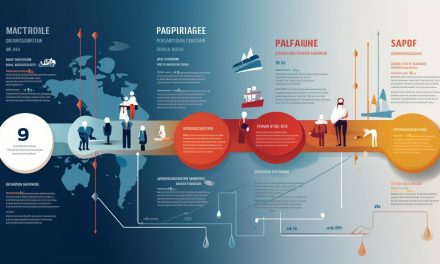Job enrichment means redesigning a role so employees gain more meaning, autonomy, and feedback. This approach draws on Herzberg’s motivators and the Job Characteristics Model to link real job features to motivation and satisfaction.
In France and beyond, companies that shape tasks around skill variety, task identity, task significance, autonomy, and feedback help staff feel recognized and trusted. Practical moves include adding mentoring duties or assigning autonomous projects to boost experience and growth.
Note: this is not simply more work. It is a smarter way to give people ownership and clearer paths for development. While enrichment often raises engagement and lowers turnover, it may not always increase output.
Table of Contents
Key Takeaways
- Job enrichment redesigns roles to add meaning, autonomy, and feedback.
- It rests on proven theories like Herzberg and the Job Characteristics Model.
- Employees gain recognition and clearer growth pathways in any company size.
- Enrichment improves engagement and employee experience; productivity gains vary.
- Practical examples include mentoring tasks and autonomous projects.
Why Work Enrichment Matters Today
Rapid change and low engagement push leaders to rethink how roles are designed and experienced.
Present-day drivers include digital transformation, shifting market demands, and compressed timelines. These forces add pressure on teams and make outdated role designs feel brittle.
Surveys show only about 13% of employees report real engagement. Gallup finds engaged staff who see meaning in their job can be roughly 21% more productive. That gap makes job enrichment a practical lever for modern management.

How enrichment boosts meaning and capability
Autonomy lets employees decide how to meet clear outcomes. This freedom raises motivation and satisfaction.
Skill variety and broader task identity reduce monotony. When people handle end-to-end tasks, they see impact on customers and peers, which builds confidence.
Feedback closes the loop. Fast, regular signals help staff correct course and sustain performance in dynamic settings.
| Driver | What to change | Immediate effect | Time-aware step |
|---|---|---|---|
| Low engagement | Co-define outcomes with employees | More meaning | One-week pilot |
| Monotony | Add varied tasks and client contact | Higher skill use | Rotate tasks monthly |
| Fast change | Give decision latitude within goals | Faster adaptation | Small autonomy trials |
| Poor feedback | Introduce short review loops | Clearer performance | Weekly check-ins |
Practical note: enrichment is not piling on tasks or simple enlargement. It reshapes job content to give more control, skill use, and meaning. Small, steady changes often add up to big engagement gains.
Defining Work Enrichment vs. Traditional Job Design
Rather than piling on duties, some companies choose to redesign roles so people own outcomes. This approach adds motivators—autonomy, feedback, and meaningful responsibility—into an existing job.
What job enrichment actually means
Job enrichment deepens a role by increasing autonomy, clear feedback, task identity, and significance. It gives employees more control over methods while keeping outcomes aligned with company goals.
How this differs from classic design and enlargement
Traditional job design often split tasks for efficiency. That can create monotony and weak connection to results.
By contrast, job enlargement is horizontal: it adds more tasks at the same level. Enlargement raises variety but not responsibility or decision rights.
| Approach | Main change | Typical effect |
|---|---|---|
| Traditional design | Task specialization | High efficiency, low meaning |
| Job enlargement | More similar tasks | Less monotony, limited growth |
| Job enrichment | Depth, autonomy, feedback | Greater motivation, skill growth |
Example: give an employee end-to-end ownership of a process or add mentoring duties rather than only adding similar tasks. That re-balance builds decision-making, problem-solving, and long-term capability.
The Science Behind Enrichment: Herzberg to the Job Characteristics Model
Theories from Herzberg and Hackman & Oldham give managers a practical roadmap to improve role quality. These models explain which job elements raise motivation and satisfaction.

Herzberg’s motivators: recognition, responsibility, achievement
Herzberg separates hygiene factors (pay, policies) from true motivators. Recognition, responsibility, and achievement drive lasting satisfaction.
Practical point: timely, specific recognition reinforces behaviors leaders want to see every day.
Hackman & Oldham’s core dimensions
The five dimensions are: skill variety, task identity, task significance, autonomy, and feedback. Each links to psychological states that matter.
| Dimension | Manager action | Psychological state | Expected outcome |
|---|---|---|---|
| Skill variety | Broaden skills used | Experienced meaningfulness | Higher motivation |
| Task identity & significance | Give end-to-end ownership; clarify impact | Meaning and purpose | More satisfaction |
| Autonomy | Let employees choose methods | Experienced responsibility | Ownership, intrinsic motivation |
| Feedback | Provide rapid, specific signals | Knowledge of results | Better quality and learning |
What research says about mediators and outcomes
A meta-review of nearly 200 studies (Fried & Ferris, 1987) validated the model and found psychological states mediate links between job characteristics and outcomes like motivation and performance.
Use these factors as a short diagnostic checklist. Start where the gap is biggest—skill use, autonomy, or feedback—and pilot changes. For more practical steps, see career enrichment.
Benefits and Real-World Impact on Satisfaction and Performance
Small changes that increase decision latitude and recognition can reshape how staff experience their day-to-day roles. These adjustments often translate into higher motivation and clearer paths for growth.
Motivation and skill growth: Challenging tasks and new responsibilities push people to learn technical and soft skills. When employees gain mentoring duties or end-to-end project ownership, confidence rises and career mobility improves.

Lower turnover, less absenteeism, better communication
Roles that offer meaningful variety reduce boredom and increase belonging. That lowers turnover and absenteeism over time.
Enriched roles also make feedback loops natural: employees ask for timely input and managers see progress earlier, which improves communication and alignment.
The productivity nuance
Meaningfulness tends to boost quality, initiative, and problem-solving. However, volume of output may not rise immediately.
Research shows happier staff can be about 13% more productive on average, but leaders should prioritize intrinsic drivers—recognition, autonomy, and clear goals—over short-term throughput gains.
- Example: add mentoring or full-project ownership to a job to increase satisfaction and motivation.
- Clarify outcomes, set feedback cadence, and track both sentiment and delivery metrics.
- Measure employee satisfaction with surveys and operational outcomes like cycle time and quality.
For practical steps on measuring sentiment and designing roles that lift employee satisfaction, see employee satisfaction.
Common Barriers and Challenges Companies Face
Introducing deeper role responsibility often meets a human barrier: fear of the unknown. Managers and employees can worry that added responsibility will mean more hours, unclear goals, or unfair evaluation.

Resistance and misalignment with goals
Why people resist: uncertainty about changing duties, loss of routine, and unclear links to company strategy. When a job shift does not match business goals, employees see added tasks as meaningless and satisfaction falls.
Training, resources and supervisory limits
Expanding responsibility demands new skills and time. Training costs, limited coaching bandwidth, and legacy supervisory systems often block progress.
Growth-need strength: when change backfires
Not everyone wants a deeper role. Some people prefer stability. For those with lower growth needs or limited skills, job enrichment can cause stress rather than motivation.
« Calibration matters: match new responsibilities to readiness, not just intent. »
| Barrier | Impact | Practical fix |
|---|---|---|
| Resistance | Low buy-in; stalled pilots | Engage management early; co-design roles |
| Resource limits | Delayed training; quality dips | Run small pilots; allocate coaching time |
| Misalignment | Perceived irrelevance; lower satisfaction | Map tasks to strategic goals; clarify outcomes |
Tip: start small, gather employee feedback, and adjust pace so changes fit people, skills, and company needs.
Work Enrichment Techniques That Actually Work
Concrete tactics help teams gain autonomy and clearer purpose while keeping goals aligned. Try one change at a time and measure results.
Autonomy, vertical loading, and decision rights
Vertical loading gives people more decision rights over methods and outcomes. Keep coaching active so learning follows mistakes, not blame.
Skill variety and natural work units
Combine related tasks into a single unit so an employee owns a product or service end-to-end.
Example: at Corning Glass Works, combining assembly tasks raised productivity 84%, cut rejects from 23% to under 1%, and reduced absenteeism to under 1%.
Feedback loops and client contact
Use 360 feedback, direct client interaction, and clear success criteria. Fast, specific signals accelerate learning and confidence.
Participation, recognition, and automation
Quality circles and suggestion programs let people propose improvements. Recognize implemented ideas with timely rewards.
Automate repetitive steps to free staff for higher-value tasks and new responsibilities.
| Technique | Main benefit | Quick example/metric | First step |
|---|---|---|---|
| Vertical loading | More control | Faster decisions | Pick one role to expand decision rights |
| Natural work units | Task identity | Corning: +84% productivity | Group end-to-end tasks |
| 360 & client feedback | Clear learning | Higher quality | Schedule monthly reviews |
| Quality circles & automation | Continuous improvement | Fewer rejects, more time | Pilot suggestion program |
Practical start: choose one strategy—client contact or vertical loading—define success criteria, pilot for a month, and iterate based on feedback. For tools on measuring role impact, see job fulfillment.
Implementing Enrichment in Practice
A measured, data-first approach makes role redesign less risky and more targeted. Start small, gather clear signals, and scale what works.
Diagnose: use the Job Diagnostic Survey
The Job Diagnostic Survey gives a motivating potential score from meaningfulness, autonomy, and feedback.
Meaningfulness is the average of skill variety, task identity, and task significance. Compare scores to spot which dimension needs attention.
Co-create with design thinking
Empathize, ideate, prototype with employees. Run short pilots so solutions match daily reality and company goals.
Train, enable, and support
Provide training and tools before adding responsibility. Managers must coach, not just assign, and protect time for learning.
Monitor outcomes over time
Track satisfaction, engagement, and role fit along with performance. Use regular feedback check-ins and adjust quickly.
« Start with data, co-design with employees, and measure results — that keeps change practical and fair. »
- Quantify motivating potential first.
- Prototype solutions with small groups.
- Align strategies to company goals and clarify decision rights.
- Combine experience metrics with performance indicators.
Job Enrichment vs. Job Enlargement
When roles gain meaning and control, motivation shifts from external to internal. That difference matters for long-term satisfaction and quality.
Horizontal loading versus depth, control, and autonomy
Job enlargement means adding more tasks at the same responsibility level. It often raises task variety and can reduce boredom short term.
Job enrichment adds depth: more autonomy, feedback, and significance. That depth builds ownership and stronger intrinsic motivation.
When enlargement helps—and the risk of job creep
An example: a warehouse employee gets inventory duties in addition to picking. At first, the change adds variety and a fresh challenge.
Over months, however, tasks can pile up without added authority or support. This drift—job creep—leads to overwhelm and lower quality.
- Define horizontal loading as more duties without added decision rights.
- Pair enlargement with autonomy or faster feedback to keep motivation high.
- Ensure responsibilities grow with authority; otherwise performance suffers.
- Use job analysis for cross-training or short-term coverage, not permanent overload.
« Add tasks then add depth: feedback, decision rights, and clarity of impact. »
Practical rule: if you increase tasks, set limits, review cadence, and add control. Enriched jobs tend to lift quality and learning; enlargement alone rarely boosts sustained productivity.
Conclusion
Small, targeted shifts in duties can turn routine tasks into learning steps and real career progress.
Job enrichment centers on meaning, autonomy, and clear feedback to lift employee satisfaction and engagement. Use the JDS to spot where changes will help most.
Pick one or two practical strategies to start—for example, regular feedback paired with timely recognition, or a small vertical loading step in a clear role.
Co-create changes with people, train managers to protect time, and add short review checkpoints so the approach stays aligned to goals and employee needs.
Try one small move this week, gather feedback, and build momentum. When people feel trusted and seen, both employees and the company thrive.
FAQ
What exactly is job enrichment and how does it differ from job enlargement?
Job enrichment adds depth to a role by increasing responsibility, autonomy, and opportunities for skill growth. Job enlargement expands the role horizontally by adding more tasks or duties. Enrichment emphasizes control, meaningfulness, and developmental feedback, while enlargement focuses on variety and workload. Both can improve engagement, but enrichment targets long-term motivation and purpose.
Why should companies prioritize enrichment now?
Modern drivers—skill shortages, hybrid schedules, and engagement gaps—make meaningful roles a competitive edge. Enriching roles boosts autonomy, recognition, and role significance, which improves retention, productivity, and employee experience. It also closes the gap between routine tasks and purpose, helping organizations adapt faster to change.
What core psychological models support enrichment strategies?
Classic research underpins enrichment. Herzberg highlights motivators like recognition, achievement, and responsibility. Hackman & Oldham’s Job Characteristics Model identifies skill variety, task identity, task significance, autonomy, and feedback as core drivers of job satisfaction and motivation. Together they explain why richer roles improve performance and growth.
How can managers measure whether a role has motivating potential?
Use diagnostic tools such as the Job Diagnostic Survey to assess motivating potential score (MPS). Track skill variety, autonomy, feedback, and task identity. Pair this with regular feedback cycles, engagement surveys, and performance metrics to see changes over time in satisfaction, learning, and role fit.
What practical techniques improve role significance and autonomy?
Effective techniques include vertical loading (adding decision rights and responsibility), job crafting trials, role rotation through natural work units, and creating clearer client contact. Provide clear criteria for success and timely feedback. Purpose linking—tying tasks to mission or user outcomes—also increases perceived significance.
Can adding tasks alone achieve the same benefits as enrichment?
No. Simply adding tasks (horizontal loading) may increase variety but often creates overload without boosting control or meaning. True enrichment combines new responsibilities with autonomy, feedback, and skill development so employees feel ownership and see the value of their work.
What common barriers block successful implementation?
Organizations face resistance to change, misalignment with strategic goals, limited training and resources, and weak supervisory systems. Growth-need strength matters too—some employees may feel frustrated if given responsibility without support. Address these through co-creation, clear enablement, and staged pilots.
How should companies pilot enrichment without disrupting operations?
Start small with prototypes using design thinking: empathize, ideate, and prototype role changes. Run time-boxed job crafting trials, set clear metrics, and gather rapid feedback from employees and supervisors. Use quality circles or suggestion programs to scale effective changes gradually.
What role does feedback play in maintaining enriched roles?
Feedback is essential. Use 360 reviews, client contact reports, and clear performance criteria to close the loop. Timely feedback reinforces learning, clarifies expectations, and sustains autonomy. Without it, increased responsibility can feel directionless and demotivating.
How do enrichment initiatives affect turnover and absenteeism?
When well-designed, enriched roles increase engagement and meaning, which lowers turnover and absenteeism. They improve communication and recognition, fostering stronger commitment. However, if enrichment is applied poorly—without training or support—it can raise stress and attrition instead.
When is job enlargement appropriate?
Enlargement helps when tasks are repetitive and workers need more variety without added responsibility—for example, to reduce monotony on an assembly line. It works best combined with opportunities for skill development and periodic rotation to avoid job creep and stress.
How can leaders align enrichment with company strategy and performance goals?
Tie role changes to clear business outcomes and competencies. Use diagnostics to identify high-impact roles, co-create changes with employees, and provide training plus managerial support. Monitor outcomes like productivity, skill growth, and engagement to ensure alignment with company priorities.
What metrics should HR track to evaluate success?
Track a mix of qualitative and quantitative indicators: engagement and satisfaction scores, motivating potential index, turnover and absenteeism rates, learning and skill acquisition, and role-fit measures. Also monitor productivity trends while controlling for external factors.
How do automation and technology fit into enrichment strategies?
Use automation to remove dull, repetitive tasks so employees can focus on higher-skill work and decision-making. Smart automation paired with job crafting increases variety and enables meaningful client contact. Avoid automating away opportunities for skill development or autonomy.
What can employees do personally to increase the motivating potential of their roles?
Employees can proactively job craft: seek new responsibilities, volunteer for cross-functional projects, request clearer feedback, and connect their tasks to larger outcomes. Discuss growth paths with managers and ask for training to build skills and autonomy.





